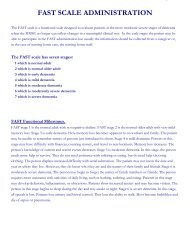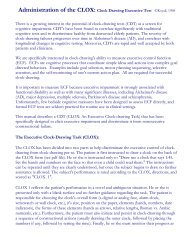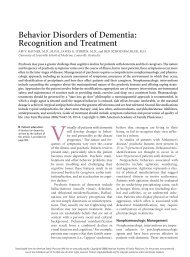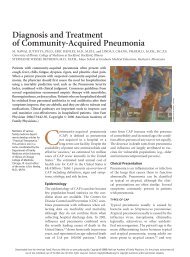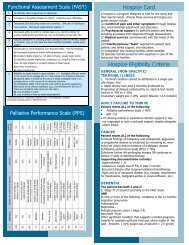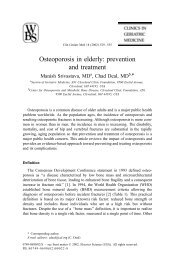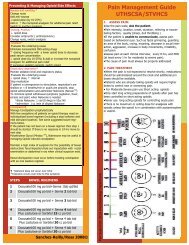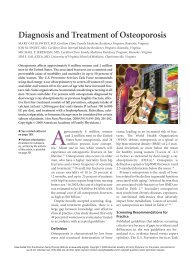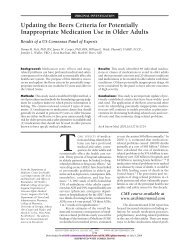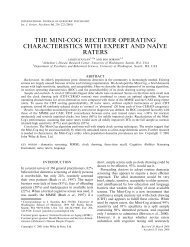Delirium -- American Family Physician
Delirium -- American Family Physician
Delirium -- American Family Physician
- No tags were found...
Create successful ePaper yourself
Turn your PDF publications into a flip-book with our unique Google optimized e-Paper software.
<strong>Delirium</strong>ONDRIA C. GLEASON, M.D., University of Oklahoma College of Medicine, Tulsa, Oklahoma<strong>Delirium</strong> is characterized by an acute change in cognition and a disturbance of consciousness,usually resulting from an underlying medical condition or from medicationor drug withdrawal. <strong>Delirium</strong> affects 10 to 30 percent of hospitalized patients with medicalillness; more than 50 percent of persons in certain high-risk populations are affected.The associated morbidity and mortality make diagnosis of this condition extremelyimportant. Patients with delirium can present with agitation, somnolence, withdrawal,and psychosis. This variation in presentation can lead to diagnostic confusion and, insome cases, incorrect attribution of symptoms to a primary psychiatric disorder. To makethe distinction, it is important to obtain the history of the onset and course of the conditionfrom family members or caregivers. Primary care physicians must be able to recognizedelirium so that the underlying etiology can be ascertained and addressed. Themanagement of delirium involves identifying and correcting the underlying problem,and symptomatically managing any behavioral or psychiatric symptoms. Low doses ofantipsychotic drugs can help to control agitation. The use of benzodiazepines should beavoided except in cases of alcohol or sedative-hypnotic withdrawal. Environmentalinterventions, including frequent reorientation of patients by nursing staff and educationof patients and families, should be employed in all cases. (Am Fam <strong>Physician</strong>2003;67:1027-34. Copyright© 2002 <strong>American</strong> Academy of <strong>Family</strong> <strong>Physician</strong>s.)Without careful assessment,delirium can easilybe confused with a numberof primary psychiatricdisorders becausemany of the signs and symptoms of deliriumare also present in conditions such as dementia,depression, and psychosis. Some characteristicsigns and symptoms of delirium aredescribed in this article. All of these symptomsmay not be present in every patient. The presentationof a patient with delirium will fluctuateduring the course of the condition andeven during the course of a day. The diagnosticcriteria for delirium are listed in Table 1. 1Acute Onset/Fluctuating Levelsof Consciousness<strong>Delirium</strong> is characterized by an acutechange (usually over hours to days) in mentalstatus. Patients demonstrate fluctuating levelsThe primary causes of delirium are an underlying medicalcondition, medication, or drug withdrawal.of consciousness that they often manifest byperiodically falling asleep during an interview.This fluctuation in consciousness can result inconflicting reports from various caregiversabout the patient’s mental state. Fluctuationsin cognitive skills, including memory, language,and organization, are also common.ATTENTION IMPAIRMENTPatients with delirium demonstrate attentiondifficulties. They may not rememberinstructions and may ask that directions andquestions be repeated. Useful screening methodsto identify attention problems includeasking patients to spell a word backwards orperform “serial 7s” (counting backward from100 by sevens).MEMORY IMPAIRMENT AND DISORIENTATIONMemory deficits, especially where recentevents are concerned (e.g., the reason for hospitalizationor for care being given by nursingstaff), are also prominent in patients withdelirium. Patients may report not beingbathed or bedding not being changed when,in fact, these events occurred earlier in the day.Disorientation to date, place, and situation isMARCH 1, 2003 / VOLUME 67, NUMBER 5 www.aafp.org/afp AMERICAN FAMILY PHYSICIAN 1027
<strong>Delirium</strong>apathetic. <strong>Delirium</strong> in these patients may gounrecognized or be confused with depressionor dementia. The mixed subtype is characterizedby fluctuations between the hyperactiveand hypoactive subtypes.Screening ToolsSeveral screening tools are available to aid inidentifying delirium. The Folstein Mini-MentalState Examination (MMSE) 2 is familiar tomost physicians. It screens for deficits in orientation,attention, memory, language, andvisuoconstruction abilities. Administering theMMSE several times during the course ofdelirium can be a way to assess improvement.Comparison with an MMSE performedbefore the onset of the delirium is ideal.Another screening tool is the ConfusionAssessment Method. 3 The <strong>Delirium</strong> RatingScale (DRS) 4 and the Memorial <strong>Delirium</strong>Assessment Scale (MDAS) 5 measure the severityof delirium.Indications of Underlying MedicalConditionsRecognizing delirium is important because itis an indication of an underlying medical conditionthat should be identified and treated.The underlying etiology should be aggressivelysought after. <strong>Delirium</strong> can be caused by a medicalemergency or a subacute, chronic medicalcondition (Table 2). 6 Prescription drugs, illicitdrugs, and toxic substances can also cause delirium.The underlying medical condition is notalways readily identifiable, and more than oneetiology is often responsible for delirium. Infact, in almost one half of elderly patients withdelirium, two or more underlying conditionsare responsible for the delirium. 7Visual hallucinations are more characteristic of delirium thanof a primary psychiatric disorder.effect of medication or substance abuse. Whilevisual hallucinations can occur in patientswith primary psychiatric illnesses such asschizophrenia, they are much less commonthan auditory hallucinations. In primary psychiatricdisorders, visual hallucinations wouldbe associated with other, more characteristicsigns and symptoms of the disorders. Visualhallucinations that occur in patients withdelirium can be formed (e.g., people, animals)or unformed (e.g., spots, flashes of light).Electroencephalography (EEG) can be usefulin differentiating delirium from other conditions.In patients with delirium, the EEGshows a diffuse slowing of the backgroundTABLE 2Differential Diagnosis of <strong>Delirium</strong> Using the Mnemonic‘I WATCH DEATH’The rightsholder did notgrant rights to reproducethis item in electronicmedia. For the missingitem, see the original printversion of this publication.Differentiating <strong>Delirium</strong> from PrimaryPsychiatric DisorderCertain signs and symptoms can helpphysicians distinguish between delirium and apreexisting psychiatric disorder. For example,visual hallucinations are an indicator of anunderlying metabolic disturbance or adverseMARCH 1, 2003 / VOLUME 67, NUMBER 5 www.aafp.org/afp AMERICAN FAMILY PHYSICIAN 1029
<strong>Delirium</strong> can be exacerbated by overstimulation orunderstimulation in the environment.The AuthorSYMPTOMATIC TREATMENTDuring the search for an underlying medicalcondition, symptomatic treatment for deliriummay include the use of antipsychoticdrugs to control agitation and hallucinations,and to clear the sensorium (i.e., improve attentionabilities and level of orientation).Haloperidol (Haldol) has been studied mostoften in the symptomatic management ofdelirium, 8 but risperidone (Risperdal) 15,16 andolanzapine (Zyprexa), 17 which are newer, atypicalantipsychotics, have been the subjects of afew case reports. Two small studies 18,19 witholanzapine suggested that this drug might be auseful alternative in the treatment of delirium.In most adult patients with delirium ofmoderate severity, haloperidol therapy can beinitiated at 1 to 2 mg twice daily, repeated everyfour hours as needed, and can be administeredvia IV, oral, or intramuscular routes. The IVroute has been shown to produce a lower incidenceof extrapyramidal side effects 20 ;however,it does carry a risk for the development oftorsades de pointes. 21,22 Preferably, patientsreceiving IV haloperidol should be on a cardiacmonitor. QTc prolongation greater than450 msec or more than 25 percent above baselineshould prompt the physician to considerdiscontinuing haloperidol therapy, or a cardiologyconsultation should be obtained. 8ONDRIA C. GLEASON, M.D., is assistant professor of psychiatry and director of psychiatryresidency training at the University of Oklahoma College of Medicine, Tulsa.She is also a staff psychiatrist at Saint Francis Hospital, Tulsa, Okla. Dr. Gleason earnedher medical degree from the University of Nebraska College of Medicine, Omaha, andcompleted a residency in psychiatry at the University of Iowa Hospitals and Clinics,Iowa City.Address correspondence to Ondria C. Gleason, M.D., University of Oklahoma Collegeof Medicine at Tulsa, Department of Psychiatry, 4502 E. 41st St., Tulsa, OK 74135-2512 (e-mail: ondria-gleason@ouhsc.edu). Reprints are not available from the author.Elderly patients should be started at lowerdrug dosages. In these patients, haloperidoltherapy can be started at 0.25 to 1.0 mg twicedaily and repeated every four hours, asneeded. 8 Risperidone therapy can be initiatedat a dosage of 0.5 mg twice daily and increasedgradually if necessary. In all patients, responseto antipsychotics and the amount of asneededmedication used should be monitoredat least every 24 hours.If as-needed medication is necessary on aregular basis, the amount of scheduledantipsychotic should be increased. Whenpatients’ cognitive states stabilize, antipsychoticsshould be continued over the next fewdays, then tapered and discontinued. <strong>Physician</strong>sshould not automatically discontinueantipsychotics on the first day the patient’smental status shows improvement, because theimprovement may just be a normal fluctuationin the delirium. Gradual tapering that ends indiscontinuation allows time to assess patients,to ensure that the delirium has resolved andavoid rapid rebound of symptoms.ENVIRONMENTAL INTERVENTIONSEnvironmental interventions that can helpin managing patients with delirium are listedin Table 7. 23 Assigning patients to a room nearthe nursing station will allow for closer monitoring.The presence of a family member orclose friend can also be helpful. In more severecases, the use of 24-hour, one-on-one supervisionmay be necessary to monitor the patientand assist in controlling agitation. Frequentreorientation by nursing staff and familymembers is important. Patients should bereminded of the month, year, day of the week,time of day, and reason for hospitalization.Patients should also be reminded of the nameof the hospital, city, and state. A calendar,clock, and family pictures displayed withinpatients’ view can be beneficial.Understimulation resulting from absence ofcues about the time of day and the situationshould be avoided, but overstimulationshould also be avoided. The activity, light, and1032 AMERICAN FAMILY PHYSICIAN www.aafp.org/afp VOLUME 67, NUMBER 5 / MARCH 1, 2003
<strong>Delirium</strong>noise (including that from beepers) in andaround the patients’ rooms should be monitored.Frequent checking of vital signs duringthe night should be avoided unless the necessityis clearly indicated, because frequent wakingcan lead to sleep deprivation, which mayworsen delirium. 24The use of physical restraints should beavoided, if possible. Physical restraint canincrease agitation and the risk for injury inpatients who are cognitively impaired. However,if other measures to control a patient’sbehavior are ineffective and it seems likely thatthe patient, if unrestrained, may cause personalinjury or injure others, restraints can beused with caution. Patients who are restrainedshould be monitored closely, and restraintsshould be discontinued as soon as possible.<strong>Physician</strong>s should be aware of hospital policiesand other regulations regarding the use ofphysical restraints. 25<strong>Delirium</strong> can be a frightening experiencefor patients and family members. Patients mayfear that they are losing their minds. Educatingpatients and family members about deliriumand its association with underlying medicalconditions is important. Unless there isreason to believe that a patient has experiencedpermanent loss of cognitive function,the patient and family members should bereassured that the symptoms are temporaryand should resolve. Neurologic consultationcan help establish a differential diagnosis inpatients with delirium. Psychiatric consultationcan aid in distinguishing delirium from aprimary psychiatric disorder and in managingthe behavior disturbances associated withdelirium.COURSE AND PROGNOSISConsiderable morbidity and mortality areassociated with delirium. Patients with deliriumhave longer hospital stays and more medicalcomplications, such as pneumonia andpressure ulcers. Mortality is also higher inpatients with delirium, probably as a result ofmore severe underlying medical pathology.The mortality rate among elderly hospitalizedpatients with delirium is estimated to rangefrom 22 to 76 percent. 8The course of delirium can last from severalhours to several months. Through appropriateidentification and correction of the underlyingetiology, most patients experience completeresolution of delirium, although fullrecovery of mental function may lag behindTABLE 7Environmental Interventions in Treating Patients with <strong>Delirium</strong>Provide support and orientationCommunicate clearly and concisely; give repeated verbal reminders of the day,time, location, and identity of key persons, such as members of the treatmentteam and relatives.Provide clear signposts to patient’s location, including a clock, calendar, andchart with the day’s schedule.Place familiar objects from patient’s home in the room.Ensure consistency in staff (e.g., a key nurse).Use television or radio for relaxation and to help the patient maintain contactwith the outside world.Involve family members and caregivers to encourage feelings of security andorientation.Provide an unambiguous environmentSimplify care area by removing unnecessary objects; allow adequate spacebetween beds.Consider using private room to aid rest and avoid extremes of sensory experience.Avoid using medical jargon in patient’s presence because it may encourageparanoia.Ensure that lighting is adequate; provide a 40- to 60-watt night light to reducemisperceptions.Control sources of excess noise (e.g., staff, equipment, visitors); aim for fewerthan 45 dB during the day and fewer than 20 dB during the night.Maintain room temperature between 21.1°C (69.98°F) and 23.8°C (74.8°F)Maintaining competencyIdentify and correct sensory impairments; ensure patients have their glasses,hearing aids, and dentures. Consider whether interpreter is needed.Encourage self-care and participation in treatment (e.g., ask patient forfeedback on pain).Arrange treatments to allow maximum periods of uninterrupted sleep.Maintain activity levels: ambulatory patients should walk three times daily;nonambulatory patients should undergo full range of movement exercise for15 minutes three times daily.Adapted with permission from Meagher DJ. <strong>Delirium</strong>: optimising management.BMJ 2001;322:146.MARCH 1, 2003 / VOLUME 67, NUMBER 5 www.aafp.org/afp AMERICAN FAMILY PHYSICIAN 1033
<strong>Delirium</strong>corrected laboratory values by several days.Without treatment, however, progression tostupor, coma, or death can occur. Patients whoare elderly and those who have HIV infectionare less likely to fully recover. 26,27The author indicates that she does not have any conflictsof interest. Sources of funding: none reported.REFERENCES1. Diagnostic and statistical manual of mental disorders:DSM-IV-TR. Washington, D.C., <strong>American</strong> PsychiatricAssociation, 2000.2. Folstein MF, Folstein SE, McHugh PR. “Mini-mentalstate”. A practical method for grading the cognitivestate of patients for the clinician. J PsychiatrRes 1975;12:189-98.3. Inouye SK, van Dyck CH, Alessi CA, Balkin S, SiegalAP, Horwitz RI. Clarifying confusion: the confusionassessment method. A new method for the detectionof delirium. Ann Intern Med 1990;113:941-8.4. Trzepacz P, Baker R, Greenhouse J. A symptom ratingscale for delirium. Psychiatry Res 1988;23:89-97.5. Breitbart W, Rosenfeld B, Roth F, Smith MJ, CohenK, Passik S. The Memorial <strong>Delirium</strong> AssessmentScale. J Pain Symptom Manage 1997;13:128-37.6. Wise MG, Trzepacz PT. <strong>Delirium</strong> (confusionalstates). In: Rundell JR, Wise MG, eds. Textbook ofconsultation-liaison psychiatry. Washington, D.C.:<strong>American</strong> Psychiatric Publishing, 1996:258-74.7. Francis J, Kapoor WN. <strong>Delirium</strong> in hospitalizedelderly. J Gen Intern Med 1990;5:65-79.8. Practice guideline for the treatment of patientswith delirium. <strong>American</strong> Psychiatric Association.Am J Psychiatry 1999;156(5 suppl):1-20.9. Stiefel F, Holland J. <strong>Delirium</strong> in cancer patients. IntPsychogeriatr 1991;3:333-6.10. Perry S. Organic mental disorders caused by HIV:update on early diagnosis and treatment. Am J Psychiatry1990;147:696-710.11. Tune LE. Postoperative delirium. Int Psychogeriatr1991;3:325-32.12. Fann JR. The epidemiology of delirium: a review ofstudies and methodological issues. Semin ClinNeuropsychiatry 2000;5:64-74.13. Cole MG, Primeau FJ, Elie LM. <strong>Delirium</strong>: prevention,treatment, and outcome studies. J GeriatrPsychiatry Neurol 1998;11:126-37.14. Davies AD. The influence of age on trail makingtest performance. J Clin Psychol 1968;24:96-8.15. Sipahimalani A, Masand PS. Use of risperidone indelirium: case reports. Ann Clin Psychiatry 1997;9:105-7.16. Sipahimalani A, Sime RM, Masand PS. Treatment ofdelirium with risperidone. Int J Geriatr Psychopharmacol1997;1:24-6.17. Passik SD, Cooper M. Complicated delirium in acancer patient successfully treated with olanzapine.J Pain Symptom Manage 1999;17:219-23.18. Sipahimalani A, Masand PS. Olanzapine in thetreatment of delirium. Psychosomatics 1998;39:422-30.19. Kim KS, Pae CU, Chae JH, Bahk WM, Jun T. Anopen pilot trial of olanzapine for delirium in theKorean population. Psychiatry Clin Neurosci 2001;55:515-9.20. Menza MA, Murray GB, Holmes VF, Rafuls WA.Decreased extrapyramidal symptoms with intravenoushaloperidol. J Clin Psychiatry 1987;48:278-80.21. Wilt JL, Minnema AM, Johnson RF, Rosenblum AM.Torsades de pointes associated with the use ofintravenous haloperidol. Ann Intern Med 1993;119:391-4.22. Sharma ND, Rosman HS, Padhi ID, Tisdale JE. Torsadesde pointes associated with intravenoushaloperidol in critically ill patients. Am J Cardiol1998;81:238-40.23. Meagher DJ. <strong>Delirium</strong>: optimising management.BMJ 2001;322:144-9.24. Inouye SK, Bogardus ST, Charpentier PA, Leo-SummersL, Acampora D, Holford TR, et al. A multicomponentintervention to prevent delirium in hospitalizedolder patients. N Engl J Med 1999;340:669-76.25. HCFA overrules JCAHO restraint standard. HospPeer Rev 2000;25:88-9.26. Rockwood K. The occurrence and durations ofsymptoms in elderly patients with delirium. JGerontol 1993;48:M162-6.27. Fernandez F, Levy JK, Mansell PW. Management ofdelirium in terminally ill AIDS patients. Int J PsychiatryMed 1989;19:165-72.1034 AMERICAN FAMILY PHYSICIAN www.aafp.org/afp VOLUME 67, NUMBER 5 / MARCH 1, 2003



